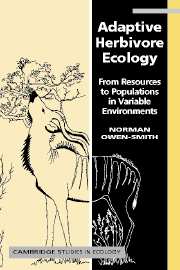Book contents
- Frontmatter
- Contents
- Acknowledgements
- Acronym and symbol conventions
- 1 Conceptual origins : variability in time and space
- 2 Consumer–resource models : theory and formulation
- 3 Resource abundance : intake response and time frames
- 4 Resource distribution : patch scales and depletion
- 5 Resource quality : nutritional gain and diet choice
- 6 Resource constraints : physiological capacities and costs
- 7 Resource allocation : growth, storage and reproduction
- 8 Resource production : regeneration and attrition
- 9 Resource competition : exploitation and density dependence
- 10 Resource-dependent mortality : nutrition, predation and demography
- 11 Habitat suitability : resource components and stocking densities
- 12 Resource partitioning : competition and coexistence
- 13 Population dynamics : resource basis for instability
- 14 An adaptive resource ecology : foundation and prospects
- References
- Index
13 - Population dynamics : resource basis for instability
Published online by Cambridge University Press: 04 February 2011
- Frontmatter
- Contents
- Acknowledgements
- Acronym and symbol conventions
- 1 Conceptual origins : variability in time and space
- 2 Consumer–resource models : theory and formulation
- 3 Resource abundance : intake response and time frames
- 4 Resource distribution : patch scales and depletion
- 5 Resource quality : nutritional gain and diet choice
- 6 Resource constraints : physiological capacities and costs
- 7 Resource allocation : growth, storage and reproduction
- 8 Resource production : regeneration and attrition
- 9 Resource competition : exploitation and density dependence
- 10 Resource-dependent mortality : nutrition, predation and demography
- 11 Habitat suitability : resource components and stocking densities
- 12 Resource partitioning : competition and coexistence
- 13 Population dynamics : resource basis for instability
- 14 An adaptive resource ecology : foundation and prospects
- References
- Index
Summary
Populations of large mammalian herbivores are notorious for their propensity to ‘irrupt’ to high abundance, followed by a crash to lower density in a degraded environment (Caughley 1970, 1976a; McCullough 1997). The archetypal example is provided by mule deer inhabiting the Kaibab region of Arizona (Rasmussen 1941). Better-documented cases exist for reindeer occupying islands off Alaska (Scheffer 1951; Klein 1968), and for white-tailed deer in mainland as well as island situations in North America (McCullough 1997). Persistent oscillations in abundance have been shown by feral Soay sheep inhabiting islands in the Hebrides off Scotland (Clutton-Brock et al. 1991, 1997; Grenfell et al. 1992, 1998). The moose population occupying Isle Royale in Lake Superior has periodically increased to high abundance, followed by substantial dieoffs, despite the arrival of wolves as predators (Peterson 1999). Several ungulate species have exhibited severe population crashes in a large private nature reserve in South Africa, precipitated by drought conditions in a situation where water supplies had been augmented (Walker et al. 1987). Drought-related dieoffs have been widely documented for free-ranging livestock, especially in communal grazing systems (McCabe 1987; Scoones 1993; Hatch and Stafford Smith 1997).
However, most ungulate populations show no more than minor fluctuations in abundance from year to year, although long-term trends or even cycles may be apparent in association with changes in vegetation, climate or other environmental features. The key feature distinguishing unstable dynamics is periodic severe mortality reducing population abundance by half or more within a brief period.
Information
- Type
- Chapter
- Information
- Adaptive Herbivore EcologyFrom Resources to Populations in Variable Environments, pp. 301 - 334Publisher: Cambridge University PressPrint publication year: 2002
